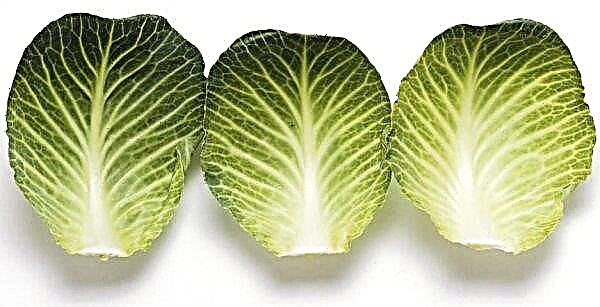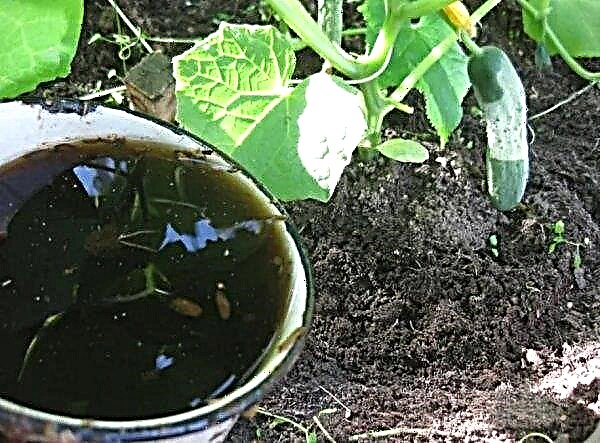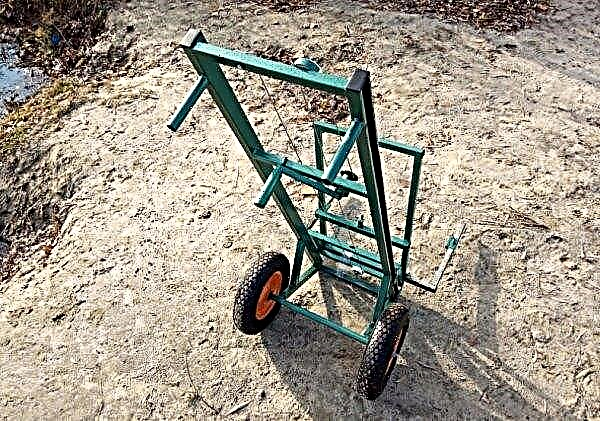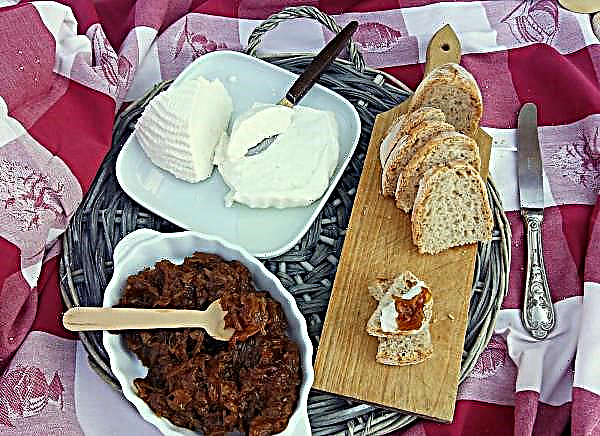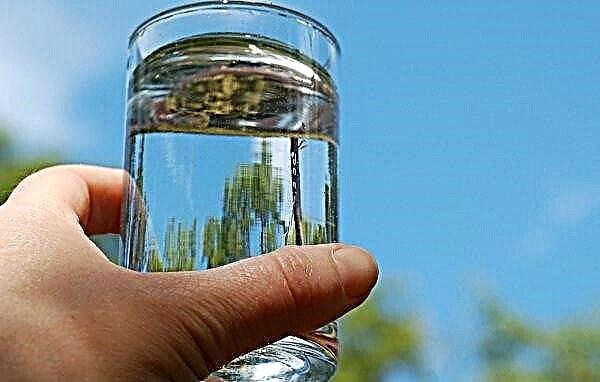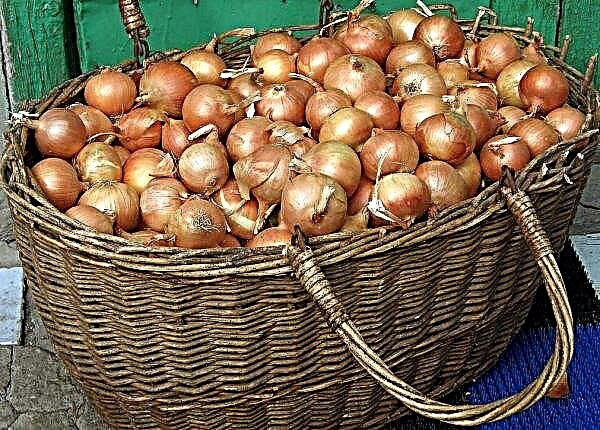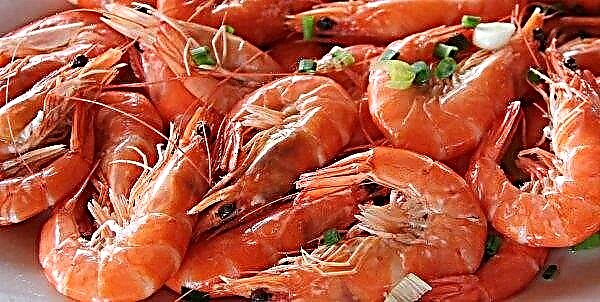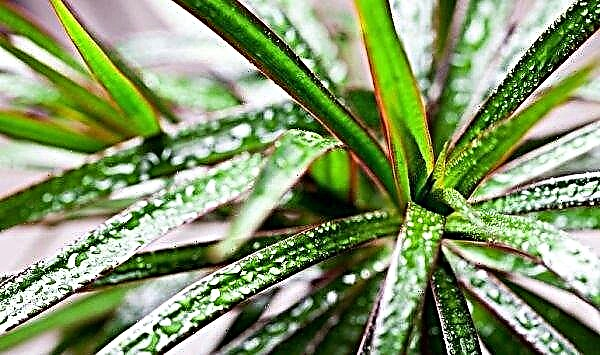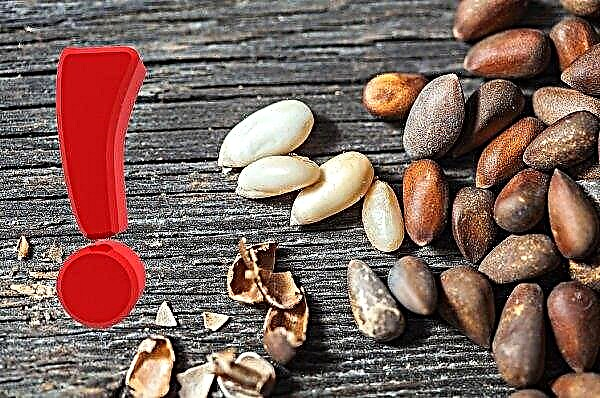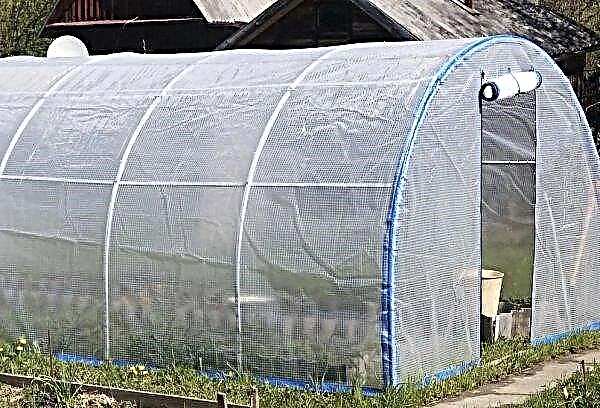Ksyusha blackcurrant variety has good winter hardiness and drought tolerance, and also brings abundant crops. The description of this variety, its general characteristics and agricultural production technique are presented later in the article.
Description of the variety of black currant Ksyusha
The bush of Ksyusha currant grows to 1.5 m. Annual shoots are light green in color and do not have pubescence. Branches that have reached 3 years of age, lignified, light brown in color. The kidneys are ovoid in shape and large in size, with a crimson color.
Leaf plates have 5 blades. The color of the leaves is light green, the surface is leathery, wrinkled. The flowers are pale pink, the sepals are slightly curved.
Did you know? In Russia currant cultivation most often practiced at monasteries, so it was often called the “monastery berry".
Selection history
Ksyusha was included in the State Register for the West Siberian Region in 1998. This variety was bred at the Siberian Research Institute of Horticulture. M. A. Lisavenko in Barnaul and obtained by crossing varieties Dikovinka and Jet.

Appearance, characteristics of berries, ripening time, yield
This currant is a medium-ripening variety - the berries begin to ripen in early July. The fruits are large, reaching a weight of up to 4 g. The skin is black in color, with a glossy sheen, compacted. The soft part has a loose structure and contains a large number of seeds. According to gardeners who cultivate the variety, the taste of berries is good, after their use there is a sweetness with a sour aftertaste.
From one shrub per season, up to 5 kg of berries are harvested, from 1 ha, the collection reaches up to 46 tons.

| Vitamin Composition: | Mineral composition: |
|
|
The energy value of currant berries per 100 g:
- calories - 44 kcal;
- proteins - 1 g;
- fats - 0.4 g;
- carbohydrates - 7.3 g.
Advantages and disadvantages of the variety
- Among the advantages of the variety of black currant Ksyusha are the following:
- winter hardiness up to –30 ° С;
- excellent drought tolerance;
- good fruit transportability;
- persistent immunity to powdery mildew and gall aphids;
- berries do not crack at elevated temperatures.
The disadvantage of shrubbery is susceptibility to septoria and anthracnose. Also, the culture may be invaded by kidney mites.
Agricultural technology
In order to grow a currant bush that is beautiful and resistant to disease, it is necessary first of all to choose the right seedling for planting. It is best to purchase planting material in specialized stores or local nurseries, which will guarantee the authenticity of the variety.
The seedling should be at least 30 cm high and have a developed root system up to 20 cm long. Do not buy planting material that has diaper rash or rot on its surface.
 To stimulate good root growth, before planting, they must be immersed in a solution of Kornevin (1 g per 1 liter of water). Duration of soaking - 2-3 hours
To stimulate good root growth, before planting, they must be immersed in a solution of Kornevin (1 g per 1 liter of water). Duration of soaking - 2-3 hours
Seat selection and landing
A place for planting currant bushes should be well lit. The southern or southeastern side of the site, which is not a draft, is excellent. The soil for cultivation should be light and loose, the pH of the soil should be neutral.
The occurrence of groundwater at the landing site should not be higher than 1.5–2 m in depth, because the currant rhizome is very long - up to 2 m, and excessive soil moisture can provoke its decay.
Important! Ksyusha can also be grown in partial shade, but then the berries will be more acidic in taste and smaller.
Currants need to be planted on previously prepared soil. Six months before planting, it is necessary to clean the area of excess vegetation and other debris, and fertilize the soil using 5 kg of humus, 300 g of wood ash and 50 g of superphosphate for every 1 m² of area.
 Planting is carried out in the spring so that the seedlings can adapt faster and grow stronger for the cold season.
Planting is carried out in the spring so that the seedlings can adapt faster and grow stronger for the cold season.
The process of planting seedlings in open ground:
- Dig a hole with a depth of 50 cm and a width of 45 cm.
- Pour the soil substrate prepared from 10 kg of the upper soil layer, 5 kg of humus, 30 g of superphosphate to the middle of the pit.
- Introduce the plant into the planting pit and gently straighten the rhizome along the embankment from the substrate.
- Fall asleep to the top with regular soil and compact it tightly.
- Pour the plant with 5 liters of water and mulch peat near the trunk.

Care
In general, the plant needs to be irrigated 2-3 times a month. Watering should be distributed in such a way that the introduction of water necessarily falls on the flowering and ripening period of the fruits.
Water for irrigation should be defended for 2 days. For 1 shrub, 10-15 l of liquid will be required, depending on the age of the plant and the speed of drying the soil.
Important! After each irrigation or rain, it is necessary to loosen the soil in order to avoid the formation of a dense crust on the soil surface and to allow oxygen to penetrate as deep as possible to the rhizome.
Currant dressing:
- In the spring make nitrogen fertilizers in the form of a solution: 30 g of urea per 10 liters of water. Pour the top dressing into specially made furrows dug at a distance of 20 cm from the trunk. One bush requires 10 l of solution.
- In the middle of summer use organic fertilizer. Prepare a solution of 2 kg of manure per 10 liters of water. This amount of fertilizing will be enough for 1 bush.
- Autumn digging on 1 m² add 5 kg of humus, 30 g of potassium and 200 g of wood ash.

Pest and Disease Control
Ksyusha is most susceptible to diseases such as septoria and anthracnose. Of the pests, the largest damage is caused by the mites, against which it has no immunity.
Anthracnose - A type of fungal infection that affects the plant during heavy rains or is the result of improper care. Spots of different diameters form on the leaves: they have a white color and a red-brown edging. After some time, the spots dry out and get enough sleep. Leaves begin to fall, which reduces yield.
Anthracnose control:
- Loosening the soil around the trunk.
- Harvesting and burning damaged leaves.
- Irrigation with a 1% solution of copper oxychloride (100 g per 10 l of water).

Septoria manifested in moments of high humidity. Brown spots, reaching a diameter of 4 mm, begin to form on the entire surface of the sheet plate. The disease provokes a slowdown in growth and falling of leaves.
- Fighting Septoria:
- Conducting sanitary pruning.
- Spraying with a 1% solution of Bordeaux fluid (100 g per 10 liters of water).

Kidney tick is a microscopic insect reaching a length of 0.2 mm. The pest has a white color, on the body there are 4 legs. Females lay offspring in the buds of the plant. With the arrival of spring heat, new individuals are born that feed on the juice of leaves and flowers. The invasion of the tick adversely affects productivity, and also inhibits the development of the entire plant.
Tick control:
- Spraying with "Karbofos" (5 ml per 10 l of water).
- The use of a soap solution made from 300 g of laundry soap and 10 l of warm water.

Trimming and shaping a bush
Formative pruning begins from the moment of bush planting. All shoots should be cut at a height of 5-10 cm from the soil. If you do not prune from the moment of planting, the bushes will develop poorly, and will also give a poor harvest.
In the 1st year growth bush will give at least 3 more shoots. From the 2nd year the plant begins to bear fruit, many annual shoots appear, and zero branches grow, the growth point of which begins with the rhizome. All shoots are cut by 20 cm. Zero branches are cut into a ring. From the 3rd year the life of the shrub begins to prune old shoots - they are distinguished by a dark brown color. Leaving 2-3 branches of different ages, the remaining branches are removed.
 Fig. 1. Currant pruning: a - annual seedling; b - a biennial bush; c, d - shortening of shoots. Fig. 2. Currant bush before anti-aging pruning (a), after it (b) and pruning of a neglected bush (c)
Fig. 1. Currant pruning: a - annual seedling; b - a biennial bush; c, d - shortening of shoots. Fig. 2. Currant bush before anti-aging pruning (a), after it (b) and pruning of a neglected bush (c)
In addition, sanitary pruning is carried out annually, consisting in the removal of broken, dry shoots damaged by pests and diseases.
Wintering
In order for the plant to comfortably winter, you need to first prepare the site. The area is cleared of leaves and other plant debris, so as not to provoke the multiplication of fungal spores, as well as partially destroy the offspring of pests that hide in winter in fallen leaves.
Did you know? The name "currant" comes from the word "currant", which means a very strong smell. Over time, this word was transformed into "stench" and acquired a negative meaning - "a very unpleasant smell."
If the plant is planted in warm regions or with a temperate climate, then the bushes can not be covered for a period of cold weather. In areas where there is a lot of snow, you can also do without covering the plants. Snow cover will warm the shrub no worse than any shelter.
 In regions with harsh climates where winter temperatures drop below –30 ° C, it is better to use spruce branches or burlap in order to preserve the plant during the winter cold
In regions with harsh climates where winter temperatures drop below –30 ° C, it is better to use spruce branches or burlap in order to preserve the plant during the winter cold
Harvesting and transportation of the crop, shelf life of berries
In order for berries to retain their presentation for longer, they need to be harvested in dry weather. It is advisable to carry out the harvesting process in the morning or in the evening. The fruits are removed along with the stalks and placed in paper, wooden or plastic containers.
Fresh berries can be stored for 2 days. If it is necessary to preserve the fruits for longer, they are picked a little immature and placed in sealed bags. Such a product is stored at a temperature of from 0 ° C to + 4 ° C for 21 days.

Gardeners should pay attention to the variety of black currant Ksyusha. It is beneficial to cultivate it in regions with arid summers and harsh winters, and thanks to the resistance to most fungal infections, these berries can also be grown in the humid climate of the Moscow Region.

